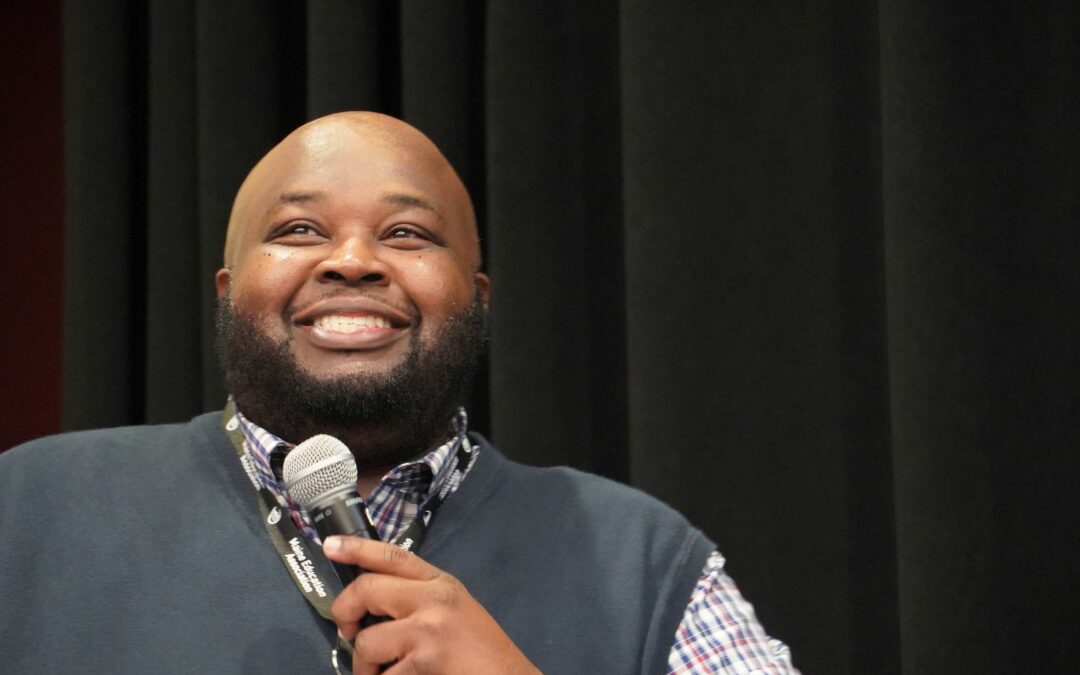Rodney Robinson, the 2019 National Teacher of the Year, delivered a powerful keynote address at the Maine Education Association Summer Conference, focused on the importance of addressing implicit biases and systemic racism to create a more equitable education system.
In July, nearly 200 educators gathered at the University of Southern Maine to hear from 2019 National Teacher of the Year, Rodney Robinson of Virginia. Robinson taught at Virgie Binford Education Center, a school inside the Richmond Juvenile Detention Center in Richmond, Virginia, and is now the Director of Teacher and Leader Pathways for Richmond Public Schools.
During his passionate keynote address, Robinson shared that his inspiration to become an educator stemmed from his mother’s unfulfilled dream of teaching. Despite never having the opportunity to be a teacher herself due to segregation, she remained the most influential educator in his life. Her lessons in teaching his sister, who had a disability, profoundly shaped Robinson’s career and his understanding of the critical need for equity in education.
Robinson also fondly recalled Dr. Lewis, his high school assistant principal. Dr. Lewis recognized Robinson’s potential and provided invaluable guidance, assisting him with college applications. This mentorship played a pivotal role in helping Robinson gain admission to college and ultimately transformed his life.
A Personal Journey Toward Equity
Rodney Robinson stressed that recognizing students’ needs and providing essential support—much like Dr. Lewis did for him—is crucial for establishing an equitable education system. Not all students begin on an equal playing field, some will always require extra assistance to achieve their full potential. However, they all deserve a quality education. As Robinson said to attendees, “A good teacher knows what each child needs and delivers accordingly.”
According to Robinson, the first step toward more equitable schools involves introspection. Educators must look in the mirror and understand how their personal history and experiences influence their interactions with students. Acknowledging our own biases and backgrounds is essential for fostering an inclusive learning environment.
Later in the day, Robinson led a breakout session that delved deeper into this concept. He emphasized the importance of addressing implicit bias—the attitudes or stereotypes that unconsciously shape our understanding, actions, and decisions. Recognizing and challenging these biases is a critical step toward greater equity in education.
However, Robinson argued that to create an equitable education system, it is essential to recognize how systemic racism has impacted educator recruitment throughout history and contributed to the racial gap that is still prevalent in education today. To create a truly equitable system, we must confront these systemic challenges head-on.
The Roots of Inequality
To dig deeper, session participants explored the unintended consequences of the landmark Brown v. Board of Education decision and its lasting impact. Remarkably, 70 years after that pivotal decision, we continue to grapple with the underrepresentation of black educators.
The statistics are striking. While only 20% of educators in the United States are BIPOC (Black, Indigenous, People of Color), over 54% of students in public schools fall into that category. In Maine, the disparity is even more pronounced. Just over 4% of teachers in Maine identify as BIPOC, despite students of color making up over 12% of the student population in the Pine Tree State,[1] and some school districts in Maine are significantly more diverse than the state average, like Portland Public Schools where 52%[2] of students are students of color. Even in these more diverse districts, the overall disparity remains.
Robinson attributed these staggering statistics to generations of black students, like his mother, who were discouraged from entering the education field after the Brown vs Board decision—which determined that segregating schools was illegal. In fact, after Brown, 40,000 black educators lost their jobs[3], and many teaching programs at historically black colleges and universities (HBCUs) were dismantled.
“Rodney’s insights pushed us to reflect on our own practices and consider new strategies for fostering diversity and inclusion in education to help create better experiences for all,” said Jesse Hargrove, MEA President.
It is essential to recognize that educational research consistently underscores the value of representation in education. Research shows that when students of color learn from teachers of color, they are 7% more likely to complete high school, 13% go onto college[4], twice as likely to be referred to Gifted and Talented programs, and face fewer suspensions and disciplinary action.[1]This underscores the critical role that diverse educators play in fostering equitable learning environments.
Building a More Equitable Future
Robinson’s closing remarks emphasized the ongoing importance for educators to engage in self-reflection—to look in the mirror and consider how our life experiences have shaped our beliefs, attitudes, and biases about ourselves and others. By identifying and addressing our implicit biases, we can create more inclusive and supportive school environments for both students and staff.
So, how can we find better ways to connect with students?
Dr. Sara E. Rimm-Kaufman and Dr. Krystal Thomas propose four components to reduce implicit bias and foster meaningful connections with students*:
- Become Self-aware & Unlearn Prejudicial Habits: Implicit biases often develop unconsciously, influenced by media portrayals and cultural messages. We may be completely unaware of these biases. The first step is to recognize when prejudice occurs, reflect on how our backgrounds contribute to it, and actively replace stereotypes with new, unbiased thinking.
- Learn About Your Students & Their Perspectives: Take time in the classroom to truly listen to your students. Understand their points of view, identify their interests, and cultivate empathy. Seek opportunities to incorporate aspects of their culture, language, and customs into the learning environment.
- Individuals to Counteract Stereotypes: Recognize that each student is unique. Tailor your approach to meet their individual needs. Challenge stereotypes by treating students as individuals rather than making assumptions based on group characteristics.
- Transform the School Climate & Culture: Build trusting relationships with students, families, fellow teachers, and administrators. Consider power dynamics within the school community. Amplify the voices of those who are often marginalized or left out of decision-making processes.
Sources:
[1] K-12 Demographic Data Dashboards – TNTP
[2] Fast Facts – Portland Public Schools. (n.d.). (https://www.portlandschools.org/about/fast-facts)
[3] Sara Carlsen, KUFMS. The Unintended Consequences of Brown v. Board of Education,
(https://www.youtube.com/watch?v=z4UARsqclMU) (Accessed: 30 August 2024).
[4] Sara Carlsen, KUFMS. The Unintended Consequences of Brown v. Board of Education,
(https://www.youtube.com/watch?v=z4UARsqclMU) (Accessed: 30 August 2024).
*Rimm, Kaufman, & Thomas (2024) [APA Div. 15 Practice Brief]. White, middle-class teachers and culturally different students: Applying psychology to become culturally responsive.
TRY IT!
Examine Your Implicit Bias Activity:
This activity can be used for self-reflection or as a tool for examining implicit biases with students or colleagues. By understanding your biases, you can make more conscious and equitable decisions.
- Think about how you see yourself and how others see you.
- On the palm of the hand, write one thing from the list that is a core value of your identity.
- On each of the fingers and thumb, write an important value, role, group, or affiliation that also defines your identity.
family role
friendship
religion
race
workplace role
volunteer role
gender identity
age
gender
ethnic group
country of origin
sexual orientation state
mental health
physical health
hobby/interest
geographic location
neighborhood
language
Debrief:
- Examine the list and identify which values are not written in your hand. How can the values that are left out of your hand contribute to your implicit biases?
- Example: If religion is not a core value, maybe you are not aware of when you plan events or meetings on holidays.
- How might your bias or “blind spots” manifest in your life or your teaching?
- How can you work to understand and empathize with experiences different than your own lived experience?
Learn More
Examine Your Implicit Biases
Resources to sharpen our racial analysis and to deepen our understanding of implicit biases, microaggressions, and stereotypes: https://www.nea.org/resource-library/implicit-bias-microaggressions-and-stereotypes-resources




